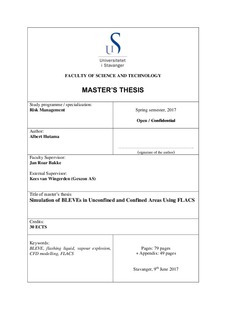| dc.contributor.advisor | Bakke, Jan Roar | |
| dc.contributor.advisor | van Wingerdeen, Kees | |
| dc.contributor.author | Hutama, Albert | |
| dc.date.accessioned | 2017-09-21T11:26:59Z | |
| dc.date.available | 2017-09-21T11:26:59Z | |
| dc.date.issued | 2017-06-09 | |
| dc.identifier.uri | http://hdl.handle.net/11250/2455997 | |
| dc.description | Master's thesis in Risk management | nb_NO |
| dc.description.abstract | BLEVE is a type of explosion that constitutes a major hazard in (but not limited to) the process industries, and which may lead to catastrophic effects. It can happen in storage facility or in transport system (road and train tankers). The subsequent effects of BLEVEs such as blast overpressure, fireball, and so on are the main considerations for safety engineers to achieve an acceptable and required level of safety during operations.
To have a better understanding of the consequences of a possible BLEVE accident, computer simulations may be required because of their ability to perform many calculations in a relatively short time. But, unlike the well-known expanding gas process, the flashing liquid process that occurs in a BLEVE accident involves more complex physics. The complexity necessitates simplification to be able to describe the flashing process. Interactions between the BLEVE itself and confinement and congestion have to be analysed when discussing possible BLEVEs inside a tunnel, such as may be possible during transport by train or truck.
To establish a proper method to simulate a BLEVE, the simulation approach by Hansen and Kjellander (2016) is used as a starting point. To simplify the description of the flashing process Hansen and Kjellander (2016) used a pseudo-source. Several adaptations have been made regarding the pseudo-source region. In addition, some simulations required several trials to achieve a more consistent method.
Regarding the blast overpressures and impulses, the simulation results are mostly above the actual experiment results. These may represent a more conservative value which is good from a safety point of view. This satisfactory level of results does not happen for fireball simulations. Fireball characteristics are below the values of actual experiments. Several changes on the simulation setups are necessary to reproduce fireball properties seen in actual experiments.
A BLEVE inside a semiconfined area will have a lower decay rate of blast overpressure due to the confinement. Relatively high overpressures are observed at far distances from the centre of the explosion. Congestion will introduce turbulences and will disturb the blast wave, thus reducing the overpressures. | nb_NO |
| dc.language.iso | eng | nb_NO |
| dc.publisher | University of Stavanger, Norway | nb_NO |
| dc.rights | Navngivelse 4.0 Internasjonal | * |
| dc.rights.uri | http://creativecommons.org/licenses/by/4.0/deed.no | * |
| dc.subject | BLEVE | nb_NO |
| dc.subject | flashing liquid | nb_NO |
| dc.subject | vapour explosion | nb_NO |
| dc.subject | CFD modelling | nb_NO |
| dc.subject | FLACS | nb_NO |
| dc.subject | risk management | nb_NO |
| dc.subject | risikostyring | nb_NO |
| dc.title | Simulation of BLEVEs in Unconfined and Confined Areas Using FLACS | nb_NO |
| dc.type | Master thesis | nb_NO |
| dc.description.version | submittedVersion | nb_NO |
| dc.subject.nsi | VDP::Samfunnsvitenskap: 200 | nb_NO |

